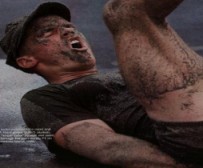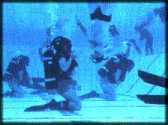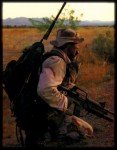|
|
|
|
 BUD/S training is the most difficult military training in the entire world. Trainees go through months of physical training, swimming/diving (SCUBA) training, and land warfare/demolition training. The physical requirements are the toughest in existence, with one week, appropritely named Hell Week, where trainees go through more intense training, with only 4 hours of sleep at best. Here is all the info about Indoctrination, BUD/S Training's 3 phases, and Post BUD/S Training. BUD/S Indoctrination 2 Weeks This is a mandatory course and it is designed to give students an understanding of the technique and performance required of him. The first obstacle is faced when the student must pass the BUD/S Physical Screen Test in order to class up and start training. First Phase (Physical Conditioning) 8 Weeks Continued physical conditioning in the areas of running, swimming and calisthenics grow harder and harder as the weeks progress. Students will participate in weekly four mile timed runs in boots, timed obstacle courses, swim distances up to two miles wearing fins in the ocean and learn small boat seamanship.  The first four weeks of First Phase prepare you for the fifth week, better known as "Hell Week." During this week, students participate in five and one half days of continuous training, with a maximum of four hours of sleep for the entire week. This week is designed as the ultimate test of one's physical and mental motivation while in First Phase.
Hell Week proves to those who make it that the human body can do ten times the amount of work the average man thinks possible. During Hell Week you will learn the value of the mainstay of the SEAL Teams; TEAMWORK! The remaining three weeks are devoted to teaching various methods of conducting hydrographic surveys and how to prepare a hydrographic chart.
The first four weeks of First Phase prepare you for the fifth week, better known as "Hell Week." During this week, students participate in five and one half days of continuous training, with a maximum of four hours of sleep for the entire week. This week is designed as the ultimate test of one's physical and mental motivation while in First Phase.
Hell Week proves to those who make it that the human body can do ten times the amount of work the average man thinks possible. During Hell Week you will learn the value of the mainstay of the SEAL Teams; TEAMWORK! The remaining three weeks are devoted to teaching various methods of conducting hydrographic surveys and how to prepare a hydrographic chart.
Second Phase (Swimming/Diving) 7 Weeks  After you have completed First Phase, you have proven to the instructor staff that you are motivated to continue more in-depth training. During this period, physical training continues, but the times are lowered for the four mile run, two mile swims, and obstacle course. Second Phase concentrates on combat SCUBA (Self Contained Underwater Breathing Apparatus). Students are taught two types of SCUBA: open circuit (compressed air) and closed circuit (100% oxygen). Emphasis is placed on a progressive dive schedule emphasizing basic combat swimmer skills that will qualify you as a combat diver. These skills will enable you to tactically operate and complete your combat objective. This is a skill that separates SEALs from all other Special Operations Forces.
After you have completed First Phase, you have proven to the instructor staff that you are motivated to continue more in-depth training. During this period, physical training continues, but the times are lowered for the four mile run, two mile swims, and obstacle course. Second Phase concentrates on combat SCUBA (Self Contained Underwater Breathing Apparatus). Students are taught two types of SCUBA: open circuit (compressed air) and closed circuit (100% oxygen). Emphasis is placed on a progressive dive schedule emphasizing basic combat swimmer skills that will qualify you as a combat diver. These skills will enable you to tactically operate and complete your combat objective. This is a skill that separates SEALs from all other Special Operations Forces.
Third Phase (Land Warfare) 10 Weeks  This is the demolitions, reconnaissance, weapons and tactics phase. Physical training continues to become more strenuous as the run distances increase and the minimum passing times are lowered for the runs, swims and obstacle course. Third Phase concentrates on teaching land navigation, small-unit tactics, rappelling, military land and underwater explosives and weapons training. The final four weeks of Third Phase are spent on San Clemente island, where students apply techniques acquired throughout training in a practical environment.
This is the demolitions, reconnaissance, weapons and tactics phase. Physical training continues to become more strenuous as the run distances increase and the minimum passing times are lowered for the runs, swims and obstacle course. Third Phase concentrates on teaching land navigation, small-unit tactics, rappelling, military land and underwater explosives and weapons training. The final four weeks of Third Phase are spent on San Clemente island, where students apply techniques acquired throughout training in a practical environment.
Post BUD/S Training Length Varies  BUD/S graduates receive three weeks basic parachute training at Army Airborne School, Fort Benning, Georgia, prior to reporting to their first Naval Special Warfare Command. Navy corpsman who complete BUD/S and Basic Airborne Training also attend two weeks of Special Operations Technicians training at the Naval Special Warfare Center, Coronado. They also participate in an intense course of instruction in diving medicine and medical skills called 18-D (Special Operations Medical Sergeant Course). This is a 30-week course where students receive training in burns, gunshot wounds and trauma.
BUD/S graduates receive three weeks basic parachute training at Army Airborne School, Fort Benning, Georgia, prior to reporting to their first Naval Special Warfare Command. Navy corpsman who complete BUD/S and Basic Airborne Training also attend two weeks of Special Operations Technicians training at the Naval Special Warfare Center, Coronado. They also participate in an intense course of instruction in diving medicine and medical skills called 18-D (Special Operations Medical Sergeant Course). This is a 30-week course where students receive training in burns, gunshot wounds and trauma.After assignment to a Team and successfully completing a six-month probationary period, qualified personnel are awarded a SEAL Naval Special Warfare Classification (NEC) Code and Naval Special Warfare Insignia. New combat swimmers serve the remainder of their first enlistment (2 1/2 to 3 years) in either an SDV or a SEAL Team. Upon reenlistment, member may be ordered to remainder of a five-year sea tour. Advanced courses include; Sniper School, Dive Supervisor, Language training, SEAL tactical communication and many others. Shore duty opportunities are available in research and development, instructor duty and overseas assignments. In addition to normal pay and allowances, Naval Special Warfare personnel currently receive $175/month dive pay, $300/month SDV pay, $225/month HALO (jump pay), $110/month special duty assignment pay and $50 to $100/month language proficiency pay for specking a second language. Click here for info about becoming SEAL. |